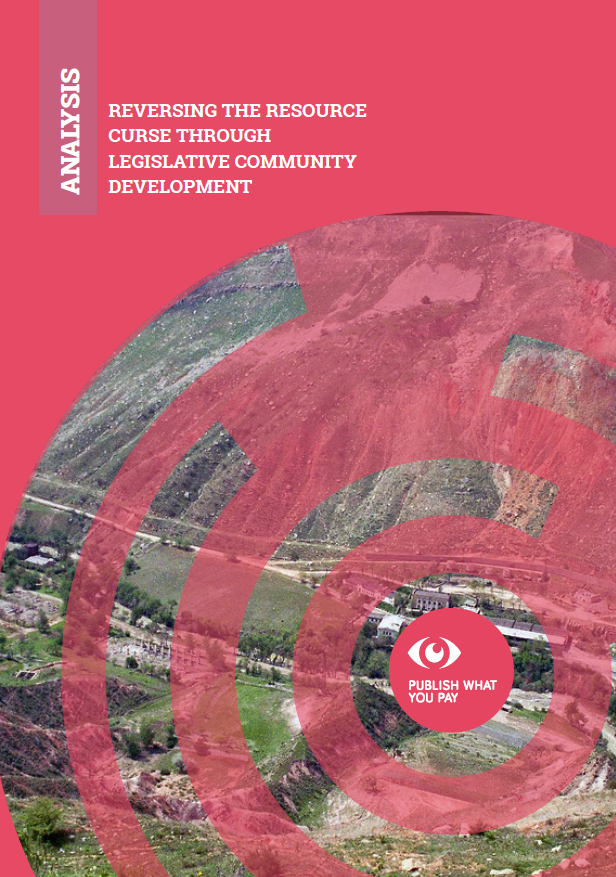On June 27, 2016, the US Securities and Exchange Commission (SEC) voted to approve regulations to implement Section 1504, or the Cardin-Lugar Amendment, of the 2010 Dodd-Frank Financial Reform and Consumer Protection Act. Section 1504 requires any oil, gas or mining company filing an annual report with the SEC to disclose their country and project-level payments to host governments each year.
● The full text of the June 2016 final rule can be read here: https://www.sec.gov/rules/final/2016/34-78167.pdf
This fact sheet was originally posted on PWYP US and can be viewed here
When will the information be disclosed?
● The SEC is adopting a 2-year phase-in period. Companies will be required to comply with the new rule for their fiscal year ending on or after September 30, 2018.
● Companies will report no later than 150 days after the end of their fiscal year.
● Since most major extractive companies’ fiscal years end on December 31, first reports are expected by May 2019.
Who must disclose?
● Companies that file an annual report with the SEC. These include companies that are listed on US stock exchanges. They are called “resource extraction issuers” in the rule. This includes approximately 755 oil, gas and mining companies, according to the SEC.
● Companies that “engage in the commercial development of oil, natural gas, or minerals.”
● These include:
o US domestic companies – Those that file Form 10-K.
o Foreign companies – Those that file Forms 20-F or 40-F (Canadian companies).
● These also include subsidiaries and “entities under the control” of the issuer, as defined by accounting principles.
o An issuer has “control” over another entity when “the issuer consolidates the entity or proportionately consolidates an interest in an entity or operation under the accounting principles applicable to [its] financial statements.” To determine if an issuer has control, it is required to follow the consolidation requirements under the US Generally Accepted Accounting Principles (US GAAP) or the International Financial Reporting Standard (IFRS). “…an issuer must disclose the payments made by entities that are consolidated, or its proportionate amount of the payments made by entities or operations that are proportionately consolidated, in its consolidated financial statements…”1
● Issuers must disclose the proportionate amount of the eligible payments made by a resource extraction issuer’s proportionately consolidated entities or operations.
● Foreign private issuers not subject to Exchange Act reporting (not listed, no registered offering) are not required to report.2
Does the rule provide any exemptions from compliance?
● The SEC will consider applications for exemptive relief on a case-by-case basis, using its existing authority under the Exchange Act. Companies seeking relief must follow the application process set forth in Exchange Act Rule 0-12.
o Under Rule 0-12 the SEC may provide notice and an opportunity for public comment on applications for exemptions.
● If a company files for an exemption because of a purported “host-country prohibition” to disclosure, the SEC will consider the specific facts and circumstances in determining whether, and to what extent, to provide exemptive relief and may request supporting documentation, for example:
o An opinion of counsel supporting a company’s claim of a foreign law prohibition;
o Representations as to the public availability of the information in question;
o A description of steps taken by the issuer to obtain permission to disclose;
o Text of applicable foreign laws (translated as necessary);
o Whether similar information has been disclosed by other companies in similar circumstances. The final rule includes two targeted exemptions related to certain newly acquired companies and new exploratory activity:
1) If an issuer acquires a company not previously subject to the rule (or the requirements of another
substantially similar jurisdiction), the issuer will not be required to start reporting on payments for the
acquired entity until the next fiscal year following the acquisition.
2) Companies may delay reporting on payments related to certain new exploratory activities for one year. However, this is limited to activities conducted prior to the development or extraction of resources and cannot be applied to payments made for exploratory activities adjacent to, or on the same property as, a current project.3
What is being disclosed?
On an annual basis, the following will be disclosed in the specified report:
1. Type and total amount of payments made for each project.
2. Type and total amount of payments made to each government.
3. Total amount of the payments, by category.
4. The government that received the payments, and the country in which the government is located.
5. The project to which the payments relate.
6. Currency used to make the payments.
7. Financial period in which the payments were made.
8. Business segment of the resource extraction issuer that made the payments.
9. The natural resource that is the subject of commercial development.
10. The subnational geographic location of the project (Issuers will report an additional tag for subnational geographic location that uses ISO codes to indicate project location).
Which categories of payments will be disclosed?
● Taxes
o Specifically included – taxes levied on corporate profits, corporate income, and production.
o Specifically excluded – taxes levied on consumption (e.g. VAT, personal income taxes, sales taxes).
o For payment obligations levied at the entity level, such as corporate taxes, issuers may disclose at the entity level.
● Royalties
o Including unit-based, value-based, and profit-based.
● Fees (including license fees)
o Includes rental fees, entry fees, and concession fees.
● Bonuses
o Including signature, discovery and production bonuses.
o Fees and bonuses identified are not an exclusive list, and there may be other fees and bonuses a resource extraction issuer would be required to disclose.
● Production Entitlements
o Oil production shared between a company and government once investment and operating costs are recovered through cost oil (the physical oil or revenue used to cover
the operator’s costs).
● In-kind
o Must disclose payment types above that are made in-kind and tag them as “in-kind” in the currency tag.
o Companies must provide a description as to how the monetary value of in-kind payments was calculated.
o Companies are required to report “at cost, and are only permitted to report using fair market value if historical costs are not reasonably available or determinable.”4 Additional payment types included in the final rule for consistency with EITI (not expressly listed in the statute):
● Dividends
o Includes those paid in lieu of production entitlements or royalties.
o Does not include dividends when the government is an ordinary shareholder in the covered company or a company under its control, and receives dividends on the same basis as other shareholders in the company.5
● Infrastructure Improvements (“such as building a road or railway”)
o Included if these are incurred, whether by contract or otherwise, to further the commercial development of oil, natural gas or minerals.
● Social and Community Payments
o If required by law or contract.
For which activities must payments be disclosed?
● Disclosure is required for payments related to the commercial development of oil, natural gas or minerals.
● This includes:
o Exploration
o Extraction – Includes the “production of oil and natural gas as well as the extraction of minerals.”
o Processing
● Includes “‘but is not limited to, midstream activities such as the processing of gas to remove liquid hydrocarbons, the removal of impurities from natural gas prior to its transport through a pipeline, and the upgrading of bitumen and heavy oil, through the earlier of the point at which oil, gas, or gas liquids (natural or synthetic) are either sold to an unrelated third party or delivered to a main pipeline, a common carrier, or a marine terminal. It would also include the crushing and processing of raw ore prior to the smelting phase.”6
● Does not include smelting or refining.
o Export – “the transportation of a resource from its country of origin to another country by an issuer with an ownership interest in the resource…”7
● Does not cover activities with “little relationship to upstream or midstream activities,” such as commodity trading-related activities.
● Does not cover movement of resource across an international border by a company that is not engaged in exploration, extraction or processing, and acquired its ownership interest in the resource directly or indirectly from a foreign government or the Federal Government.
● Does not “capture payments related to transportation on a fee-for-service basis across an international border by a service provider with no ownership interest in the resource.”8
o The acquisition of a license for any such activity
● When a service provider makes a payment to a government on behalf of an issuer.
● The rule does not require disclosure of:
o Payments for transportation except for payments made in relation to the export of oil, gas, or minerals.
o Payments related to activities that are ancillary or preparatory to commercial development, such as manufacturing drill bits. However, where a service provider makes a payment on behalf of an issuer that meets the definition of “payment,” the issuer would be required to disclose the payment.9
o Payments related to marketing activities.10
Payments to which government entities?
1. Foreign governments, defined as:
o foreign government
o a department
o agency
o instrumentality
o a company owned by a foreign government – This includes companies that are “at least majority-owned by a foreign government.” 11
2. Foreign subnational governments, including:
o states
o provinces
o counties
o districts
o municipalities
o territories
3. US Federal Government – Specifically excludes US state governments.
How is a project defined?
● A project is contract-based.
● The rule adopts a definition of “project” similar to the definition in the EU Directives and Canada’s Extractive Sector Transparency Measures Act (ESTMA):
o “the operational activities that are governed by a single contract, license, lease, concession or similar legal agreements and form the basis for payment liabilities with a government…If multiple such agreements are substantially interconnected, this shall be considered a project.”12
● The EU Directives and ESTMA define substantially interconnected as, “a set of operationally and geographically integrated contracts, licenses, leases or concessions or related agreements with substantially similar terms…”
● SEC references “interconnected” not “integrated” contracts, licenses etc.
● However, the SEC’s rule does not require projects to have “substantially similar terms” in order
to be reported as one project.
o This rationale is explained, “Operations under one agreement may lead to the parties entering into a second agreement for operations in a geographically contiguous area. If a change in market conditions or other circumstances compels a government to insist on different terms for the second agreement, then under our proposed definition the use of those different terms by themselves would not preclude treating the second agreement as the same project when, operationally and geographically, work under the second agreement is a continuation of work under the first.”13
● The SEC provides a non-exclusive list of suggested factors for issuers to use to determine whether two or more agreements are “operationally and geographically connected” and can be treated as a single project. Companies should determine:
o “(a) whether the agreements relate to the same resource and the same or contiguous part
of a field, mineral district, or other geographic area;
o (b) whether the agreements will be performed by shared key personnel or with shared
equipment; and
o (c) whether they are part of the same operating budget.”14
What is the threshold of payments being disclosed?
● Companies are required to disclose all payments that are “not de minimis.”
● “Not de minimis” means “any payment, whether made as a single payment or a series of related payments, which equals or exceeds $100,000 during the most recent fiscal year.”15
How will the information be disclosed to the public?
● All information will be publicly disclosed on an annual basis.
● Companies will file a Form SD, outside of their annual report.
● The information is electronically tagged using the eXtensible Business Reporting Language (XBRL) format.
● The information will be posted along with annual reports in SEC’s EDGAR online database and available free of charge to anyone with Internet access.
Does the SEC allow for alternative reporting?
● Companies may use alternative reports prepared under the regulations in other jurisdictions to comply with the US rule if the SEC determines that the jurisdiction’s requirements are “substantially similar” to the US rule.
● The SEC has determined that the current reporting requirements in Canada and the EU are “substantially similar,” subject to certain conditions.
● USEITI reports were also deemed “substantially similar,” but only in relation to payments made to the Federal Government.
o Reports must still be tagged in XBRL format.
o The report must be made publicly available prior to filing with the SEC.
o Reports can be filed in alignment with the other reporting jurisdictions’ timeline, as long as the SEC is given advance notice and reports are filed with the SEC no later than 2 days after the alternative jurisdictions deadline.
● Issuers, governments, industry groups, and trade associations may submit applications for additional alternative reporting determinations under Exchange Act Rule 0-13.
What kinds of liability do companies face for payment information disclosed?
● Disclosures must be “filed” rather than “furnished.”16
● Under US securities law, “filed” disclosures are subject to a private right of action. This means that shareholders may bring a civil suit in the Federal courts against companies if they document significant financial loss resulting from material misstatement of filed data.
● Moreover, the SEC may fine an issuer for filing false information in an annual report.
Does the rule specifically address attempts to evade the disclosure requirements?
● Yes. The SEC adopted a revised “anti-evasion” provision:
o “Disclosure is required under this section in circumstances in which an activity related to the commercial development of oil, natural gas, or minerals, or a payment or series of payments made by a resource extraction issuer to a foreign government or the Federal Government for the purpose of commercial development of oil, natural gas, or minerals is not, in form or characterization, within one of the categories of activities or payments specified in Form SD, but is part of a plan or scheme to evade the disclosure required under this section.”17
More information:
● To access company annual reports: www.sec.gov/edgar/searchedgar/companysearch.html
● List of foreign companies reporting to the SEC: www.sec.gov/divisions/corpfin/internatl/companies.shtml
● For information on the history of the law, or the PWYP-US campaign, please visit: www.pwypusa.org
● To learn how to dig deeper into oil, gas and mining payment data, visit: www.extractafact.org
For questions, please contact Jana Morgan, Director, PWYP-US: [email protected].
1 See SEC, Disclosure of Payments by Resource Extraction Issuers, Final Rule, June 2016, p. 26.
2 See SEC Final Rule, June 2016, p. 30.
3 See SEC Final Rule, June 2016, p. 119.
4 See SEC Final Rule, June 2016, p. 60.
5 See SEC Final Rule, June 2016, p. 44.
6 See SEC Final Rule, June 2016, p. 40.
7 See SEC Final Rule, June 2016, p. 41.
8 See SEC Final Rule, June 2016, p. 41.
9 See SEC Final Rule, June 2016, p. 39.
10 See SEC Final Rule, June 2016, p. 43.
11 See SEC Final Rule, June 2016, p. 26.
12 See SEC Final Rule, June 2016, p. 16.
13 See SEC Final Rule, June 2016, p. 65.
14 See SEC Final Rule, June 2016, p. 266.
15 See SEC Final Rule, June 2016, p. 26.
16 See SEC Final Rule, June 2016, p. 145.
17 See SEC Final Rule, June 2016, p. 257.











